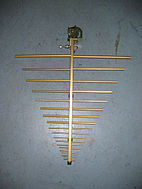
Back Richtantenne German Antena direccional Spanish Suundantenn Estonian آنتن جهتدار Persian Suunta-antenni Finnish Antenne directionnelle French Antenna direzionale Italian 지향성 안테나 Korean Kryptinė antena Lithuanian Antena kierunkowa Polish

A directional antenna or beam antenna is an antenna which radiates or receives greater radio wave power in specific directions. Directional antennas can radiate radio waves in beams, when greater concentration of radiation in a certain direction is desired, or in receiving antennas receive radio waves from one specific direction only. This can increase the power transmitted to receivers in that direction, or reduce interference from unwanted sources. This contrasts with omnidirectional antennas such as dipole antennas which radiate radio waves over a wide angle, or receive from a wide angle.
The extent to which an antenna's angular distribution of radiated power, its radiation pattern, is concentrated in one direction is measured by a parameter called antenna gain. A high-gain antenna (HGA) is a directional antenna with a focused, narrow beam width, permitting more precise targeting of the radio signals.[1] Most commonly referred to during space missions,[2] these antennas are also in use all over Earth, most successfully in flat, open areas where there are no mountains to disrupt radiowaves.[citation needed]
In contrast, a low-gain antenna (LGA) is an omnidirectional antenna, with a broad radiowave beam width, that allows the signal to propagate reasonably well even in mountainous regions and is thus more reliable regardless of terrain. Low-gain antennas are often used in spacecraft as a backup to the high-gain antenna, which transmits a much narrower beam and is therefore susceptible to loss of signal.[3]
All practical antennas are at least somewhat directional, although usually only the direction in the plane parallel to the earth is considered, and practical antennas can easily be omnidirectional in one plane. The most common directional antenna types are[citation needed]
- the Yagi-Uda antenna,
- the log-periodic antenna, and
- the corner reflector antenna.
These antenna types, or combinations of several single-frequency versions of one type or (rarely) a combination of two different types, are frequently sold commercially as residential TV antennas. Cellular repeaters often make use of external directional antennas to give a far greater signal than can be obtained on a standard cell phone. Satellite television receivers usually use parabolic antennas. For long and medium wavelength frequencies, tower arrays are used in most cases as directional antennas.
- ^ Zainah Md Zain; Hamzah Ahmad; Dwi Pebrianti; Mahfuzah Mustafa; Nor Rul Hasma Abdullah; Rosdiyana Samad; Maziyah Mat Noh (2020). Proceedings of the 11th National Technical Seminar on Unmanned System Technology 2019: NUSYS'19. Springer Nature. p. 535. ISBN 978-981-15-5281-6. Extract of page 535
- ^ Joseph A. Angelo (2014). Encyclopedia of Space and Astronomy. Infobase Publishing. p. 364. ISBN 978-1-4381-1018-9. Extract of page 364
- ^ "Low-gain antenna". Oxford Reference (oxfordreference.com).
© MMXXIII Rich X Search. We shall prevail. All rights reserved. Rich X Search

